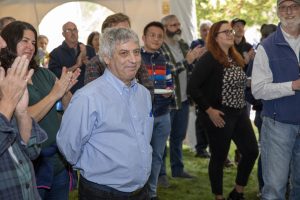Behind the Innovation: Q&A with WHOI Senior Engineer Paul Fucile about his journey from oceanography to space technology
Woods Hole Oceanographic Institution's (WHOI) senior engineer, Paul Fucile, has spent forty years working in oceanography. His work spans various disciplines, including work on sensors, bioluminescence detection, telemetry, and low-power instrumentation. In one of his latest projects, Fucile collaborated with the Massachusetts Institute of Technology (MIT) and the U.S. Naval Research Laboratory (NRL) to study ocean salinity measurements from space via CubeSats - small, typically low-orbit satellites.
Fucile recently received a patent for his on-orbit small satellite camera calibration innovation. He is a prolific inventor, and this is one of seven patents Fucile received during his time at WHOI. The Office for Technology Transfer (OTT) recently sat down with Paul to chat about his journey as an engineer, mentor, and inventor.
Can you share a little bit about your background?

Paul Fucile during WHOI Employee Appreciation Celebration.
Photo by Jayne Doucette
I've been at WHOI for forty years and have had the opportunity to work on hundreds of projects across different departments. My intellectual property experience began with a license agreement in '93 for a vehicle dynamics and control system. Since then, I've developed intellectual property in a variety of applications such as oceanography, offshore wind, and now space technology.
Additionally, I'm involved with STEM outreach as an Lemelson-MIT Invention Education Fellow and as an instructor with the Lincoln Lab Beaver Works Summer Institute. I've been mentoring with both organizations for over 10 years and have had the opportunity to support various student teams, some of whom have even earned a patent. My favorite aspect of mentoring students with the Lemelson-MIT Program is when they have those 'Eureka!' moments. One of the team members was having trouble getting her sensor amplifier to work, so I suggested adding a variable resistor to allow trimming the circuit gain. The look of accomplishment on her face as she made the adjustment to provide the expected response was priceless. The second, of course, is when the teams file their provisional patent applications, which you might understand is a pretty big accomplishment for a high school student.
Can you tell me a little about your most recent invention and how it came from your work at WHOI?
The optical calibrator came about from a project with MIT and NRL to develop a CubeSat with optical salinity retrieval capabilities. My interest in CubeSats began soon after they were first deployed from the International Space Station in 2011. These are small satellites about the size of a loaf of bread - and being an electrical engineer, after reading publications available at the time, I became reasonably familiar with how many of the subsystems worked.
After about five years of self-study and enrolling in three satellite engineering classes at MIT, a solicitation came out to develop a CubeSat to determine near-coast salinity passively. Soon, colleagues at NRL, MIT, and WHOI formed a team to explore a technological solution. WHOI served as the science lead, NRL was responsible for developing the salinity retrieval algorithm, and MIT Aero-Astro provided their satellite design and operations expertise. During the conceptual process, the NRL scientists were curious whether conducting on-orbit calibrations for the optical payload was possible, much like those being performed on bigger satellites. This possibility would be important since the algorithm to back salinity out from the optical imaging data required a relatively high level of long-term signal integrity. Since a CubeSat is typically developed and constructed at a significantly lower cost than conventional-sized earth-observing satellites, the characterization and testing often performed on a typical space system is reduced. Because of our 90-minute sampling requirement, that is, 1 per orbit, we would need to validate our sensor response on demand and not rely on often inconsistent ground-based references.
The transition from student to collaborator came quickly. When asked if building an integral calibrator for this satellite was possible, I knew to draw on experience building bioluminescence sensors (a tool that uses light-emitting reactions from living organisms to measure and detect biological and chemical changes). With an idea based on LED technology, I had to study the problem and determine how to make it work in a vacuum instead of underwater while withstanding extreme temperature changes. This called for a start with a clean sheet of paper. The result was a low-cost, miniaturized, on-orbit optical and thermal calibrator that can easily be installed into an academic or commercially available CubeSat.
What challenges did you encounter during the creation of this invention, and how did you overcome them?
The biggest challenge was shrinking a device normally the size of a basketball into something that would fit within a CubeSat payload. Conventional-sized satellite optical calibrators have been developed, but no technology this small was commercially available. The study of how to reduce a piece of technology down to the size of a ping-pong ball and have it operate in the harsh space environment was done through developing three fundamentally different laboratory prototypes.
Space technology is surprisingly similar to what we experience in oceanography, where power constraints, limitations in communications, and the need for autonomy are often encountered. While we are often concerned about operating under extreme pressure, the calibrator needed to perform in a different environment than what we are accustomed to.
Can you share any interesting or surprising moments you experienced throughout the invention process?
One word – 'vacuum'. An Oceanographic engineer is always thinking of ways to protect an instrument against the ocean's extremes and not the other way around. It was necessary to construct a purpose-built vacuum chamber to test lab prototypes. Re-purposing a retired 1500+ meter depth-rated pressure housing, I thought, "How hard can it be to adapt this mighty pressure case to operate at less than one atmosphere?". Simply plumbing it inside out did not work, and it constantly leaked. Fortunately, the cross-department expertise and diverse knowledge base at WHOI is awesome. Consulting with the Mass Spec groups at WHOI, we succeeded in holding a suitable vacuum for extended lengths of time. We are such an academically open community, and finding an answer to a problem out of your field is usually not that difficult to find.
What advice would you give to aspiring inventors or innovators?
Sketch freely, be persistent, seek advice, and question what might not be so obvious.
Is there anything else you want to share with our audience about your invention or your journey as an inventor?
My first patent with WHOI involved bioluminescence sensing deep in the ocean, and the most recent was an optical calibrator for use in space. Certainly, the 'necessity' and motivation for these were different; however, the result was still for use by scientists. Neat, huh? At my first conference where the bioluminescence bathy-photometer was being presented, someone around my age walked up and said, "Hey, you're the guy that invented that new bioluminescence sensor. I wished I had invented that!" Since then, I've always had a special motivation to think in terms of invention. WHOI is a truly special place that has always encouraged my ideas, even at first if they sound or even look like a Rube Goldberg-inspired contraption.


